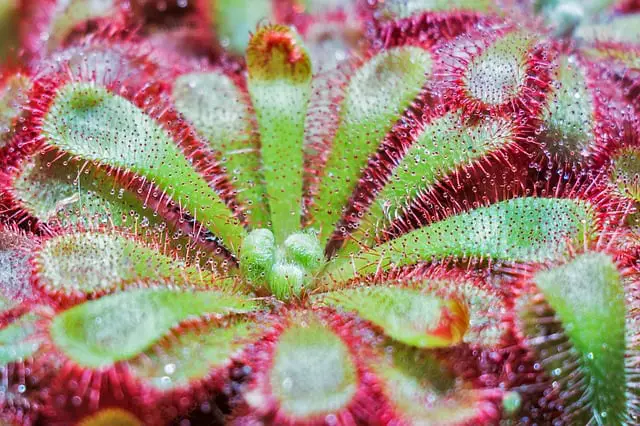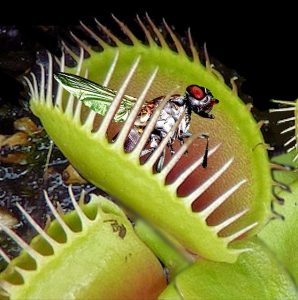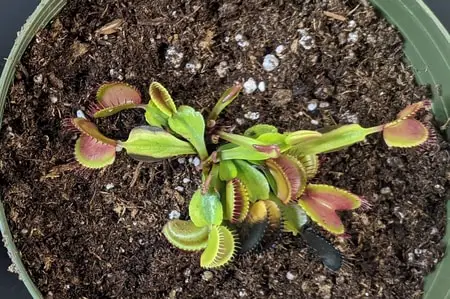In this article, I will resolve some common questions within the community: Do Venus flytraps eat gnats? and, can they serve as gnat controllers?
Venus flytraps can certainly consume gnats as they attract them with the sweet nectar inside their traps. Venus flytraps can act as gnat controllers, but other carnivorous plants are better equipped to eradicate gnats like for example the Mexican butterworts and Sundew.
There are a few considerations that reduce Venus flytrap’s success rate as a gnat controller. Here are a few options to eradicate gnats with carnivorous plants.
If you would like to learn about Venus flytrap care, read this free care guide where I share how I grow healthy Venus flytraps.
Do Venus Flytraps Eat Gnats?
It is a big misconception that Venus flytraps eat flies exclusively. Venus flytraps consume a wide variety of insects or arachnids such as ants, grasshoppers, crickets, beetles, worms, flies, and spiders.
At home, Venus flytraps can help you reduce the number of occasional bugs, including gnats. Here are a few items to consider before using Venus flytrap as nat controllers.
- Gnat sizing: Gnats are small in size. They usually reach a size of 1/8 – 1/4 of an inch. Due to their small size, they can escape easier from inside the leaves of Venus flytraps. With that said, Venus flytraps consume ants, which are smaller than most types of gnats.
- Limited trapping number: Venus flytraps can only consume a limited amount of bugs at a time. Since Venus flytraps have 3 to 10 traps, the maximum amount of bugs that a Venus flytrap can capture at a time is its number of traps. Yet, filling up all traps is very unusual.
- Slow digestion: It takes Venus flytraps several days or even a few weeks to consume a victim. Do not expect a Venus flytrap to be capturing prey daily.
- Prey selection: Venus flytraps employ prey selection to select the right meal. For example, sometimes, they let small prey escape as they weigh the cost and benefits of capturing and digesting their prey [1].
Venus flytraps can consume gnats and serve as a gnat controller in a limited way. If you have a problem with gnats, other carnivorous plants are used as a gnat controller. These are a lot more successful than Venus flytraps and will help you with your problem.
If you plan on feeding your Venus flytrap with gnats, that is a good option. However, there are some alternatives. Here is a list of food options for Venus flytraps. Also, make sure to check out the instructions to feed Venus flytraps.
Best Carnivorous Plants to Control Gnats
“Mexican butterworts and some larger sundews have been known since the Victorian age to be grown in greenhouses as a gnat controller” [2]. These two species are the recommended carnivorous plants to reduce the gnat population in your home or garden.
Mexican butterworts: These carnivorous plants have beautiful flowers and adhesive leaves. When an insect walks through or lands on a leaf, it gets stuck.
The bug can try to fight the sticky nature of the surface, but it will most likely get stuck more and more as it triggers secretive glands in the leaves. The glands produce enzymes and start digesting the bug.
Butterworts passively trap victims in their leaves. They do not select their prey or release them purposefully.
Sundews: these plants trap prey in sticky hairs that come out of their leaves. They have large tentacles that extend from the leaves. The tentacles have a sticky gland at the very end. Sundews produce nectar to attract their prey.
First, the insects get stuck to the tentacles thanks to its adhesive surface. Then, the tentacles twine around the insect and secure it. Finally, Sundews produce enzymes to digest the prey.

Both of these carnivorous plants employ adhesive leaf/tentacle mechanisms to trap their prey. The gnat size won’t impede them from capturing it. Also, because gnats are flying insects, they will be caught immediately as they land.
Related Questions
Do Venus flytraps eat fruit flies?
Yes, Venus flytraps can trap and consume fruit flies. But, we kind of answer this question earlier as fruit flies are a type of gnat, and Venus flytraps eat gnats.
There are several different types of gnats. In its majority, they reproduce quickly and can cause problems when it is an infestation. For example, fungus gnats gather in gardens or potted plants with organic material. Fruit flies feed on overripe or rotting food.
Can Venus flytraps help control bug plagues at home?
Venus flytraps can help you control the bug population at home. Yet, it won’t help you with all types of plague. Venus flytrap will only control the bug population of insects and arachnids they can consume.
 Venus flytraps can consume bugs that they can completely enclose in their traps. Most cockroaches or large beetles are too big to be captured by Venus flytraps. Flies and other flying insects are the perfect targets.
Venus flytraps can consume bugs that they can completely enclose in their traps. Most cockroaches or large beetles are too big to be captured by Venus flytraps. Flies and other flying insects are the perfect targets.
Also, there is a limitation of how many victims they can consume at a time. And once the insect it captures. Your plant will take several days to consume it and be ready for the next prey fully.
Can Venus flytraps get infested with gnats?
Yes. Gnat’s larvae can be harmful to Venus flytraps as they can feed on the plant’s leaves. Fungus gnats grow indoors, and they like high moisture environments. For that reason, they can settle in the moist soil of Venus flytrap pots, and it can be challenging to get rid of them.
The consensus is to repot the plant to eliminate the fungus gnats. First, you must remove the soil altogether. Then, inspect the plant for any egg, larvae, pupae attached to the leaves. Finally, repot.
Conclusion
Carnivorous plants won’t solve a full bug infestation problem at your home or in your garden but can reduce the bug population on a small scale. For gnat specifically, Mexican butterworts and sundews are the best carnivorous plant species to control them.
Venus flytraps eat gnats, but they won’t serve as a gnat controller. Also, remember that gnat at their larva stages can harm seedlings and young plants. So, make sure you are not exposing your more delicate plants to a gnat infestation.
If you grow Venus flytraps or are interested in starting a new hobby, make sure you learn about the Venus flytrap requirements. This article is a good start: Complete Venus Flytrap Care Instructions
Recommended Products for Carnivorous Plant Growing
- Carnivorous Plant Soil
- Carnivorous plant soil: https://amzn.to/3uVbg39
- Pure peat moss for carnivorous plants: https://amzn.to/3vTqirs
- Pure perlite: https://amzn.to/3ppckLF
- Artificial Lighting
- Small plant light for 1-4 plants: https://amzn.to/2RsGlxr
- T8 LED light fixture for multiple plants (6500k Cool White): https://amzn.to/3uWoeh2
- Pots
- Nursery pots for single plants: https://amzn.to/34Q6byu
- Net pots for single plants: https://amzn.to/2TMqgDJ
Resources
[1]https://www.sciencedirect.com/science/article/pii/S0022519318300560
[2] D’Amato, P. (2013). The Savage Garden. Berkeley, Unites States: Ten Speed Press.


